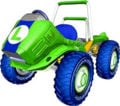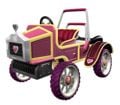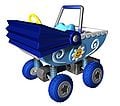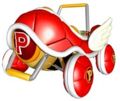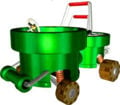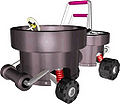Mario Kart: Double Dash!!: Difference between revisions
m (Reverted edits by Simmer Deluxe (talk) to last revision by BabyLuigiOnFire) |
|||
| Line 588: | Line 588: | ||
|JapR=Mario Kāto Daburu Dasshu!! | |JapR=Mario Kāto Daburu Dasshu!! | ||
|JapM=Mario Kart: Double Dash!! | |JapM=Mario Kart: Double Dash!! | ||
|Spa=Mario Kart: | |Spa=Mario Kart: Doble Carrera!! | ||
|SpaM=Mario Kart: Double Dash!! | |SpaM=Mario Kart: Double Dash!! | ||
|Ger=Mario Kart: Double Dash!! | |Ger=Mario Kart: Double Dash!! | ||
Revision as of 21:18, May 28, 2011
Template:Infobox Mario Kart: Double Dash!! is a video game developed and published by Nintendo for the GameCube. It combines features from earlier Mario Kart games, such as Super Mario Kart, Mario Kart 64, and Mario Kart: Super Circuit. The game features the ability for two players to ride on a kart: one to drive and one to use items. It was one of the most popular console games of 2003Template:Refneeded. Mario Kart: Double Dash!! is the fourth game of the Mario Kart series overall. The game costs three blocks for saving after each Grand Prix, changing the options for Versus mode, and more.
New Features
As every new Mario Kart game, Mario Kart: Double Dash!! shows several new features, granting a new style of playing for the users. Apart from that there are two characters per kart, the number of playable characters was increased to join the race. As implied in various Mario series games, Mario Kart: Double Dash!! contains many elements to unlock as well. By beating the cups available in every engine levels, the player unveils other hidden levels, karts, and other playable characters in the game. Furthermore, there is a more dynamic selection of karts: Every kart has specific stats that distinguishes from the others, as well capturing their respective character's style; for instance, Mario's kart, the Red Fire.
Items are the main element presented in every Mario Kart game, and Mario Kart: Double Dash!! is not an exception. These are obtainable via Item Boxes, where characters can receive any standard Item or a Special Item. The latter is an item that a specific pair of characters can receive, while all other cannot. Additionally, Power-ups dropped on the course will instantly affect the kart that would pick on it as a Banana, a Koopa Shell or a Mushroom or Star. The effects of certain items have changed considerably as well.
Another notable change featured in the game is the point system given to the racers after a competition in Grand Prix mode. From Mario Kart: Double Dash!!, this new system is used for the new Mario Kart games, Mario Kart DS and Mario Kart Wii. Also, players cannot retry a failed race in Grand Prix mode as opposed to Super Mario Kart. Users have to continue racing until finishing a cup to see the overall results. The following chart shows the difference of the point spreads from previous games to Mario Kart: Double Dash!!.
| Point Spread Comparisons | ||||||||
|---|---|---|---|---|---|---|---|---|
| 1st | 2nd | 3rd | 4th | 5th | 6th | 7th | 8th | |
| SMK + MK64 + MKSC GP | 9 | 6 | 3 | 1 | - | - | - | - |
| MKDD | 10 | 8 | 6 | 4 | 3 | 2 | 1 | 0 |
Characters
Mario Kart: Double Dash!! includes a wide number of playable characters, all of them appeared from other Mario games. Characters are divided into three classes depending on their weight: Light, Medium and Heavy. There is a total of twenty characters, which can be combined in any way, giving 190 possible character combinations.
The Drivers
- * indicates that the character is a New Driver for the Mario Kart installments overall.
- ** indicates the character's First Appearance ever to the Mario series overall (and thus, their first appearance as one of the Mario Kart drivers as well).
Starting Teams
- Normal yoshibirdo.jpeg
- BabyDD.JPG
- Koopaparatroopa.jpeg
- DKDD.JPG
- Bowser Bowserjrkart.jpg
- Normal wariowaluigi.jpeg
Unlockable Teams
- Toadtoadette.jpeg
- Peteyboo.jpeg
Supporting Characters
In addition to the twenty playable drivers in ten racing teams, numerous other Mario series characters play supporting roles in the game as well. Lakitu reprises his role as the referee of the game, meaning that he signals the start of each and every race and battle with his starting lights, alerts players when they complete a lap around the course, tells the drivers when they're going in the wrong way, waves the checkered flag to finish the race, and returns drivers to the track if they land themselves in a dangerous predicament (i.e. falling off the track). Other characters who make cameos include Shy Guys, Piranha Plants, Wigglers, Cataquacks, and Dinosaurs. Toadsworth drives the winners of a cup around Peach Beach in the Parade Kart. Piantas and Nokis from Super Mario Sunshine cheer the racers on in some race courses and join them at the award ceremonies.
Controls
Mario Kart: Double Dash!! has various controls for racing and menus. Each button on the control represents a different ability while the player is racing.
Menu Controls
 /
/ - Move
- Move - Accept option
- Accept option - Go back
- Go back
Race Controls
Single Player
 - Accelerate/Rocket Start
- Accelerate/Rocket Start - Brake/Reverse
- Brake/Reverse - Steer
- Steer /
/ - Drift/Powerslide (Hold)/Mini-Turbo (Release)
- Drift/Powerslide (Hold)/Mini-Turbo (Release) /
/ - Use item/Sound horn
- Use item/Sound horn /
/ +
+  - Throw item forward or backward
- Throw item forward or backward - Switch characters
- Switch characters - Pause/Resume game
- Pause/Resume game
Co-Op Play Only
 - Double Dash!!/Use item
- Double Dash!!/Use item - Use item
- Use item /
/ - Slide Attack
- Slide Attack - Switch characters (Press and hold)
- Switch characters (Press and hold)
Game Modes
Mario Kart: Double Dash!! contains sixteen new racing courses added, along with six new battle courses. Each racecourse contains its own difficulty and gimmicks. Up to four players can play in all the modes, excluding Time Trial mode, where only one is required. In addition, the users can play independently or in cooperative mode, an unique style of gameplay only featured in Mario Kart: Double Dash!!.
Grand Prix
In Grand Prix Mode, the player needs to win the cups against computer-controlled opponents. The difficulty level against CPU racers increases while selecting the engine class which are four:
- 50cc - Easy. The minimum top speed is low for all karts and CPU racers have a very limited selection of items. Any kart will take the 1st and 2nd place positions.
- 100cc - Intermediate/Medium. The minimum top speed is fairly average, while CPU drivers have a wider selection of items: they may use Red Shells to shoot it to the player in front of them. Lightweight karts are never in the top positions.
- 150cc - Hard. The minimum top speed in the karts is high, and CPU drivers have a wider selection of Items, most notably, the Spiny Shell's addition. In this level, CPU drivers can take down players using the items against them. Additionally, all characters race in mixed teams. CPU-controlled heavyweight karts always take the top positions.
- Mirror - Hard. Similar to 150cc engine class, as well all racecourses are turned. CPU-controlled heavyweight karts always take the top positions.
There are mainly four cups in Grand Prix mode, each one with four stages to race. These cups bear their difficulty levels as well as the racecourses within. The most basic is Mushroom Cup with simple courses and few gimmicks. The Star Cup, however, is one difficult containing long and gimmicky racecourses. All the courses have three laps, except Baby Park, which is seven for being the shortest course in length, and Wario Colosseum with only two, being the longest track in the game.
A fifth cup, the All-Cup Tour is the conglomerate of all the cups in the game. Once run in Luigi Circuit in this cup, all tracks will appear randomly to finish in Rainbow Road at last. This cup does not appear in other racing modes.
In GP Mode, two players can join a race, as themselves or in Co-op play. However it is not possible if more than two players wish to play in Grand Prix mode. In this case, players can compete for a cup in Co-op play.
Time Trial
In Time Trial, a single player races courses over a set number of laps to record the fastest completion time. Before racing, by adding the player's name entry will register their records available. When a race gets started, the characters will have two mushrooms in hand for speed boost. The best time elapsed in a lap and a race on a specific track will be saved after completing the race. Once completed the race on that racecourse, the user is able to compete against either their ghost from the current ghost data or the staff ghost within the stage. Otherwise, if a race is failed, the ghost data will not be saved. The ghost data recording can be disabled in the Options screen menu. Each ghost save is worth five blocks on the GameCube Memory Card.
Battle
A traditional mode that has presented throughout all Mario Kart games. Two to four players can compete against themselves using a variety of items (including all the special items) on the new battle arenas found in Mario Kart: Double Dash!!.
- Cookie Land
- Block City
- Nintendo GameCube
- Pipe Plaza
- Luigi's Mansion (unlockable)
- Tilt-a-Kart (unlockable)
In Battle mode it is possible to play in three sub-modes:
- Balloon Battle: The classic battle style consists on popping opponents' balloons to score, using the items from the Item Boxes. In Mario Kart: Double Dash!! the players can even "steal" balloons from their rivals, using a mushroom to dash into them or hitting with a star. This new feature's kept nowadays in current Mario Kart series games. In Co-op play, the rear player can also take away opponents' balloons while doing a slide-attack.
- Shine Thief: In Shine Thief, players must get a Shine Sprite dropped on the course and keep in hand until time runs out; on the other hand, players who couldn't take the treasure can use the items against whom got the Shine to lose it. Using a Mushroom, a Star or a slide-attack (Co-op Play), the Shine can be stolen. The Battle mode Shine Runners from Mario Kart DS was based on this sub-mode.
- Bob-omb Blast: Characters use Bob-ombs to hit their opponents and score stars to win. The bombs can be obtained by running over an Item Box. Every character can hold up to five of these explosives, and throw whether forwards or drop them backwards. Any kart that make contact with the opponent's bomb or get blown by the explosion, will lose stars. For two players, competitors need three stars to finish the battle, while for three or four players, they need four.
Versus
Versus (for two to four players) allows to racers to select their characters and karts, and compete among them on the tracks. It's also possible to play in versus mode through LAN connection where more of four players can join a competition. Additionally, there are some versus options found in the Option menu to change over the mode's gameplay:
- Number of Laps: The number of laps set over all tracks, ranging from one to nine.
- Items: The variety of items given to the racers can be changed to:
- Recommended: Default way in obtaining certain item by racer's place.
- Basic: Powerful items as lightning or stars are hardly obtainable.
- Frantic: Items such as bananas or green shells are absent.
- None: No item to use at all.
Co-op Play
Supporting the main feature in Mario Kart: Double Dash!! upon two-racers-one-kart, Cooperative Play (also said Co-op Play) lets two players control their respective character in a kart, one being the driver and the other as the item thrower. While playing in Co-op mode, the players' characters can perform special moves that a single player cannot make. The rear character can perform a slide-attack to steal an item from their rivals while messing up the rival's vehicle's controls. Both players can even double the power of the Rocket Start by pressing the respective button at the same time. This special boost is the Double Dash!!.
Notice the table seen below excludes Time Trial because Time Trial is only for single player.
| Co-op Play Modes | ||||
|---|---|---|---|---|
| Players | Grand Prix | Versus | Battle | |
| (P1-P2) | File:Check small.png | File:X mark.png | File:X mark.png | |
| (P1-P2) vs. P3 | File:Check small.png | File:Check small.png | File:Check small.png | |
| (P1-P2) vs. P3 vs. P4 | File:X mark.png | File:Check small.png | File:Check small.png | |
| (P1-P2) vs. (P3-P4) | File:Check small.png | File:Check small.png | File:Check small.png | |
Karts
| Selecting a kart by characters' size | ||
|---|---|---|
| Weight Pairings | Kart Selected | |
| Light | Light | Light Kart |
| Medium | Light | Medium Kart |
| Medium | Medium | |
| Heavy | Light | Heavy Kart |
| Heavy | Medium | |
| Heavy | Heavy | |
There are twenty-one karts available in Mario Kart: Double Dash!!, notable for having different designs and appearances, depending in the character selected to drive a vehicle. Every kart has three ratings, rated by the number of stars. The maximum amount is five.
- Acceleration: How quickly can a kart achieve its top speed.
- Speed: The level of top speed when kart goes forward.
- Weight: The weight of the kart.
Just as the characters are classified according to their weights, karts are split into three groups in size with some general characteristics:
- Light: Lightweight karts show a nice acceleration but poor top speed and low weight. They can be easily bumped away by heavier karts. They do not lose a lot of speed when they go off course.
- Medium: Medium-weight vehicles show average top speed and acceleration. Some karts within this group have slightly varied stats, though.
- Heavy: Heavyweight karts have the highest level of weight among the karts, capable of knocking apart light and medium vehicles. Many of these show high top speed, although their acceleration and off-road are fairly poor.
Each combination of characters will also determine the class of kart that will be used for the race. The table to the top right means the resulting vehicle according to the size of the characters.
An exception to this rule is the Parade Kart, where all the characters, regardless of weight, can drive on it. It is unlocked by completing All-Cup Tour in Mirror Mode.
Kart Stats
These are the kart stats that are displayed in-game.
Red Fire
Speed: 3
Acceleration: 3
Weight: 3
MEDIUMGreen Fire*
Speed: 4
Acceleration: 2
Weight: 2
MEDIUMHeart Coach
Speed: 2
Acceleration: 4
Weight: 3
MEDIUM- BloomCoach.jpg
Bloom Coach*
Speed: 3
Acceleration: 3
Weight: 2
MEDIUM Turbo Yoshi
Speed: 2
Acceleration: 4
Weight: 3
MEDIUM- Turbobirdo.jpg
Turbo Birdo*
Speed: 3
Acceleration: 3
Weight: 4
MEDIUM Goo Goo Buggy
Speed: 1
Acceleration: 5
Weight: 2
LIGHTRattle Buggy*
Speed: 2
Acceleration: 4
Weight: 2
LIGHT'Toad Kart*
Speed: 2
Acceleration: 4
Weight: 2
LIGHTToadette Kart*
Speed: 1
Acceleration: 5
Weight: 2
LIGHTKoopa Dasher
Speed: 2
Acceleration: 4
Weight: 2
LIGHTPara-Wing*
Speed: 1
Acceleration: 5
Weight: 2
LIGHTDK Jumbo
Speed: 4
Acceleration: 2
Weight: 4
HEAVY- Barreltrain.jpg
Barrel Train*
Speed: 4
Acceleration: 2
Weight: 3
LIGHT Koopa King
Speed: 5
Acceleration: 1
Weight: 5
HEAVY- Bulletblaster2.jpg
Bullet Blaster*
Speed: 4
Acceleration: 3
Weight: 1
LIGHT - Wario car.PNG
Wario Car
Speed: 4
Acceleration: 2
Weight: 4
HEAVY Waluigi Racer*
Speed: 3
Acceleration: 3
Weight: 3
MEDIUMPiranha Pipes*
Speed: 4
Acceleration: 2
Weight: 5
HEAVYBoo Pipes*
Speed: 2
Acceleration: 4
Weight: 5
HEAVY- Paradekartart.jpg
Parade Kart*
Speed: 4
Acceleration: 3
Weight: 4
ANY WEIGHT
* is unlockable
Weight Scale
For some karts, although it may look like they have the same weight in-game, they may actually be slightly heavier or lighter than the other. The list below displays all the karts from heaviest to lightest. If any karts are tied in their weight position, they cannot knock each other significantly.
| Position | Karts | In-game weight stat |
|---|---|---|
| 1-3 |
|
5 |
| 4 |
|
4 |
| 5-7 |
|
4 |
| 8-9 |
|
3 |
| 10-12 |
|
3 |
| 13 |
|
2 |
| 14-16 |
|
2 |
| 17-20 |
|
2 |
| 21 |
|
1 |
Note: In Battle Mode only, the Goo Goo Buggy's weight is tied with the Bullet Blaster.
Acceleration Scale
Despite what the stats display in-game, they can be pretty deceptive. Below is the actual acceleration scale, based on how quickly karts accelerate from 0 mph. to 40 mph..[1] The scale is from best accelerator, to worst accelerator.
| Position | Karts | Time from 0 mph. to 40 mph. | In-game acceleration stat |
|---|---|---|---|
| 1-2 |
|
00:01:551 | 5 |
|
00:01:551 | 4 | |
| 3 |
|
00:01:576 | 5 |
| 4 |
|
00:01:619 | 4 |
| 5-6 |
|
00:01:704 | 4 |
| 7 |
|
00:01:791 | 5 |
| 8 |
|
00:02:563 | 3 |
| 9 |
|
00:02:610 | 4 |
| 10-11 |
|
00:02:661 | 4 |
|
00:02:661 | 3 | |
| 12 |
|
00:02:672 | 3 |
| 13 |
|
00:02:700 | 3 |
| 14 |
|
00:02:777 | 3 |
| 15 |
|
00:02:821 | 3 |
| 16 |
|
00:03:002 | 2 |
| 17-18 |
|
00:03:108 | 2 |
| 19 |
|
00:03:214 | 1 |
| 20 |
|
00:03:236 | 2 |
| 21 |
|
00:03:363 | 2 |
Items
Traditional items from Super Mario Kart through Mario Kart: Super Circuit, appear in Mario Kart: Double Dash!! with a bunch of new power-ups to change a race drastically, such as stealing the opponent's place or item using a mushroom or reducing the racers to small size with the rare lightning. The rear character obtains a determinate item by running into an Item Box. However, Double Item Boxes give items to both the rear character and driver. The variety of items depends on the kart's place. Leader racers tend to receive basic items such as bananas or green shells, while those going under fourth place can receive rare items as a Star or a Spiny Shell.
Items are classified in two forms:
- Standard: Drivers can obtain these types of items when they go through an Item Box or Double Item Box.
- Special: Some drivers obtain a special item when that other drivers cannot obtain by an item box. When a character holds a special item, the second character cannot obtain another special item via Item Box.
Standard Items
- Green Shell – When shot, Green Shells go in a straight line, bouncing off the track walls and knocking into anything it touches, such as an item or another kart. It can be shot forwards or backwards.
- Red Shell – Red Shells home in on the nearest kart. It can be thrown backwards as well. However, when shot backwards, it acts like a green shell. Red Shells cannot bounce, however, and they break if they hit a wall.
- Spiny Shell – When shot, the Spiny Shell leads to the kart that is first place. Once it hits the kart, it creates a blue explosion. The characters in the kart lose any items if it is hit. Other karts can get hit in the blast radius. This item does not appear in Battle Mode.
- Mushroom – A Mushroom gives the kart a brief boost of speed. If used properly, it can be used to take shortcuts and to steal (or drop) items from another kart.
- Triple Mushrooms – A bunch of three mushrooms that give the drivers a boost of speed three times in a row. If characters who hold the mushrooms get hit by an item, they lose two of their mushrooms.
- Banana – When placed, a banana peel stays on the track until a kart touches it and lose its control. Bananas can be used as shields to break homing items such as red shells. It can be thrown either forward or backward.
- Star – When applied, the kart that used it becomes invincible against any item. It can also boost speed and handling of the kart. The kart is also capable of knocking out any rival kart from the course and stealing items.
- Thunderbolt – When used, the Thunderbolt shrinks, slows, and removes the items of any rival kart. If shrunken drivers get hit by an item while holding their power-ups, they lose it.
- Fake Item Box – At first sight, it looks like a Normal Item Box, but it is red with an inverted ? symbol. When used, it stays on the track until a kart hits it and spins out. The only way to get rid of these blocks is to run into it. Otherwise, this item eventually vanishes.
Special Items
- Main article: Special Item
- Fireballs (Mario/Luigi) - A set of five red (Mario) or green (Luigi) fireballs capable of ricocheting off walls. When they hit another kart, the kart will spin out and slow down. They can be thrown either forwards or backwards.
- Heart (Princess Peach/Princess Daisy) - A group of 2 hearts that will surround the kart, absorbing the impact of any item that collides with the kart (except for Chain Chomps, Spiny Shells, Stars and Thunder Bolts). If used correctly, racers can absorb the item dropped on the road and use it against the other players. The Hearts have no time limit for use. The Hearts can only take two hits.
- Yoshi Egg / Birdo Egg (Yoshi / Birdo) - A green (Yoshi) or pink (Birdo) egg. They work similarly to a red shell, chasing after a kart, knocking it out when collision occurs. After colliding, these eggs randomly let out three items that could be a Banana, a Green Shell, a Mushroom, a Star, or a Bob-omb. However, if an Egg takes too long to find a kart, the Egg will break apart, but still let out three items.
- Chain Chomp (Baby Mario / Baby Luigi) - A huge Chain Chomp is summoned and boosts the kart's speed frantically for a certain period of time, while the Chain Chomp knocks out other karts and dropping their items off. After use, Chain Chomp leaves the kart and goes following the path until it disappears. It has the same use as a Bullet Bill does in other Mario Kart games.
- Triple Shells (Koopa / Paratroopa) - An arsenal of three shells, either Green or Red, knocking other karts three times or one at a time. If the character gets hit by another item while holding Triple Shells, the character will lose all except for one shell.
- Giant Banana (Donkey Kong / Diddy Kong) - Giant Bananas can be littered either forward or backward, staying on the road until a kart collides with it. Drivers will lose control, while the Giant Banana splits into a three normal Bananas scattered into a triangle in that area.
- Bowser's Shell (Bowser / Bowser Jr.) - A humongous Spiny Shell that acts like a Green Shell, going in a straight line, and bouncing around the track, destroying items and knocking over other karts, dropping their items off. It can be thrown forwards or backwards. Curiously, Bowser's Shell tends to bounce from other special items.
- Bob-omb (Wario / Waluigi) - When used, a Bob-omb stays on the road until a kart passes near it in order to explode and blow up any kart around. It can be thrown forward or littered backward.
- Golden Mushroom (Toad and Toadette) - Gold Mushrooms provide the drivers multiple boosts of speed in a row in a period of time.
Petey Piranha and King Boo have the ability to obtain any special item, excluding Luigi's green fireballs, and Birdo's pink Egg.
Note: Although special items can only be obtained by the characters they are assigned to, if a player is holding a special item, another player can steal it by colliding with the player holding the item while under the influence of a Mushroom, Star, or Slide-Attack. Also, any character can get any special item in Battle Mode. Finally, in Co-Op Mode, the driver can pass a special item to the person in the back.
Driving Techniques
Drifting and Mini Turbo
- Main article: Drift
Drifting prevents racers from losing speed in turns or from going off the course. By keeping pressed the controller's ![]() button (or
button (or ![]() button), and tilting the stick to sides, racers make the kart turn around. While drifting, racers can gain a momentary speed boost by tilting the control stick to the sides, opposite to a corner's direction. The kart then produce sparks on its wheels. Doing this two times more, racers make the sparks become orange, then blue, and then releasing a mini turbo right after the racer lets go of the
button), and tilting the stick to sides, racers make the kart turn around. While drifting, racers can gain a momentary speed boost by tilting the control stick to the sides, opposite to a corner's direction. The kart then produce sparks on its wheels. Doing this two times more, racers make the sparks become orange, then blue, and then releasing a mini turbo right after the racer lets go of the ![]() (or
(or ![]() ) button.
) button.
This tactic can be used to perform the snaking (continuous power sliding) and elude homing hazards such as Red Shells.
Rocket Start
- Main article: Rocket Start
A Rocket Start is a speed boost given to a kart when a race starts out. To perform, racers just has to press the ![]() button to accelerate right when Lakitu's lights turn green. Players also can perform a Rocket Start if racers repeatedly tap
button to accelerate right when Lakitu's lights turn green. Players also can perform a Rocket Start if racers repeatedly tap ![]() while Lakitu counts.
while Lakitu counts.
Double Dash!!
- Main article: Double Dash!!
The Double Dash is similar to the Rocket Start. Although it is more powerful, it can only be performed in Co-op Play. The team players can press the ![]() button at the same time right when Lakitu's light turns green. Upon done perfectly, the kart bolts farther, leaving out a blue trail as result.
button at the same time right when Lakitu's light turns green. Upon done perfectly, the kart bolts farther, leaving out a blue trail as result.
Item Steal
Item stealing is snatching a power-up directly from the rival's hands in a kart. There are three ways to steal an item as long as the player's rear character holds no items. Items can be stolen when the rear racer uses a mushroom or a star to hit an opposing kart and snatch the item that one of the rivals have. In Co-op Mode, the player's rear character can use the Slide-Attack to knock other rivals and take their items away. However, if the rear character knocks a rival kart with two players holding an item, the character can get the rival rear character's item, while the rival driver drops the other item onto the track.
LAN Mode
Using the Nintendo GameCube Broadband Adapter (sold separately) attached to the game system, in Mario Kart: Double Dash!! it is possible to play via Local Area Network (LAN), using up to eight Nintendo GameCube systems connected to a hub device, or also using two consoles connected together through a cross-cable, where more than four players can join a race locally. This means that up to eight users can play independently with their friends using two or more GameCube systems with the Mario Kart: Double Dash!! game discs on.
After connecting the systems to the hub, the players should turn the systems' power button to begin. The LAN Mode option appears on screen to confirm the selection. Once LAN Mode is selected and confirmed on all participating game systems and the connections have been established, the Select Mode displays. Plauers may proceed by pressing controller's A button, the LAN Mode title screen displays to enter to play.
In the LAN Mode title screen there are three options:
- Start Game: Begin Versus LAN play.
- Select Mode: Adjust LAN setup options. This allows to the users to choose the modes of play:
- Game Mode: Select one of these game modes available: Versus, Balloon Battle Shine Thief, or Bob-omb Blast. Only in Versus mode the number of laps on the tracks and the engine classes can be changed.
- Order of Courses: Choose the way in which courses or stages will be selected: Random, All courses, one course or All-cups (only for Versus)
- Co-op: Enable or Disable Cooperative Mode
- Screen Division: This option won't be available if there is more than four Nintendo GameCube systems in use.
- Quit LAN Mode: Stop playing LAN Mode
LAN Connection
In this way, two to eight Nintendo GameCube systems are connected to an over-the-counter 10BASE-T hub. The LAN cables used to connect every game system to the hub must be compatible, otherwise, the connection won't be carried out. Every Nintendo GameCube system has to have attached their Nintendo Broadband Adapter, and the Mario Kart: Double Dash!! game disc in hand, one per system. At last, the number of GameCube controllers used depends on the number of players present.
Cross-cable Connection
Unlike LAN connection, where it uses a hub to connect GameCube systems to it, the Cross-cable connection requires of only two GameCube game systems connected between themselves, through a 10BASE-T hub-compatible cross-cable. The rest of the required equipment is similar: A Mario Kart: Double Dash!! game disc per system, the Nintendo Broadband Adapter attached to the game system, and the number of GameCube controllers regarding how many players participate.
Troubleshooting
| Occasionally the users may experience malfunctions or be unable to connect by technical problems. |
|
Beta Elements
- Main article: Mario Kart: Double Dash!!/Beta elements
Glitches
- Main article: Mario Kart: Double Dash!!/Glitches
Staff
- Main article: Mario Kart: Double Dash!!/Staff
Gallery
Quotes
For a full list of quotes, see here.
Names in Other Languages
Trivia
- In the European and American boxart, Luigi's "L" on his cap is noticeably backwards. This can imply Mario and others are racing in Mirror Mode. However, the DK logo on the DK Jumbo is not backwards. This is probably just a minor mistake by the artist.



